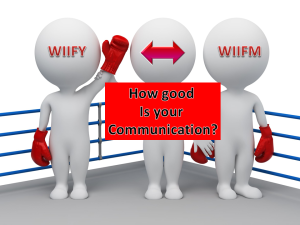 Too often people can see the value of a change for their organization (WIIFY –What’s In It For You)
Too often people can see the value of a change for their organization (WIIFY –What’s In It For You)
but don’t get how it benefits them (WIIFM – What’s In It For Me).
Recently, I tested how well 65 HR Professionals thought their organizations fared in getting their WIIFM message across when communicating change.
What follows is a summary of those questions where over 30% rated Not Well (i.e. ratings of 1 or 2).
How would you rate your own organization? (please give me your ratings by commenting to this post)
- How well do you monitor employee’s sense of fairness and trust? – 53%
- How well are you set up to ensure that real change will be the outcome of change communication? – 53%
- How well have you developed your strategy to engage employees from all disciplines in training them in how and where to initiate a change? – 45%
- How effectively do you ensure there are programs and tools in place to grow the capabilities and skills of employees that grow the business? – 32%
- How well have you planned for regular communication to inform people of every step taken, with the why, what, where, and when? – 32%
- How effectively do you ensure that all your people know and understand your change rationale? – 33%
This snapshot could be discounted as a small sample if it were not for the similarity of our survey findings.(1000+ business leaders and change consultants from 80 countries in 19 industry sectors). As we said:
“Our concerns deepened when analyzing poor communication, leadership, and resistance to change comments. Some contributor comments read like a litany of limited, delayed, inconsistent and unclear communication with poor leaders who don’t communicate how a change will work or be implemented.
For many contributors depleted and absent communication accounts for a major reason why their people do not adapt well. As one contributor commented:
“No wonder change fails, and no wonder more change fails when people experience poorly implemented change.”
For these contributors, leaders do not prepare their people for change especially how it will affect them. They allow the rumor mill to grind out a flour of Fear Uncertainty and Doubt”.
Essentially, a major reason for failed change is when poor communication increases fear, uncertainty, and doubt. These feelings are the core of change resistance. These emotions are ignored at your peril if your change effort is to stand a chance of building people’s commitment, openness, and willingness to change. (Nwosu & Anderson 2014)
[contact-form][contact-field label=’Name’ type=’name’ required=’1’/][contact-field label=’Email’ type=’email’ required=’1’/][contact-field label=’Comment’ type=’textarea’ required=’1’/][/contact-form]
